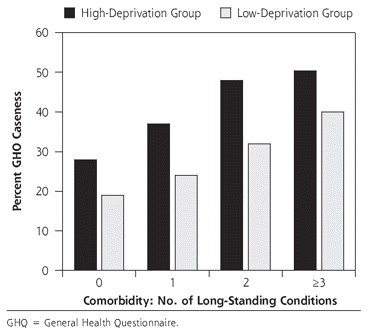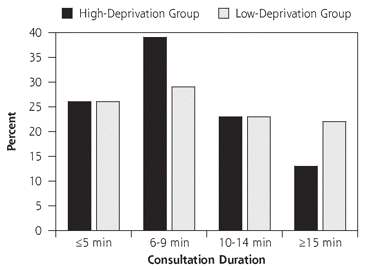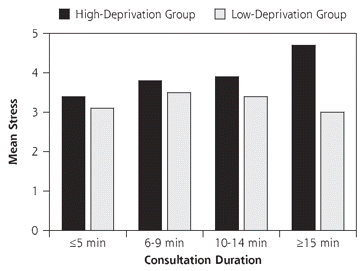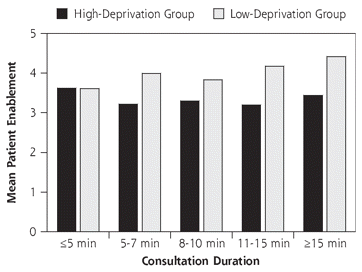The inverse care law: clinical primary care encounters in deprived and affluent areas of Scotland - PubMed (original) (raw)
Comparative Study
. 2007 Nov-Dec;5(6):503-10.
doi: 10.1370/afm.778.
Affiliations
- PMID: 18025487
- PMCID: PMC2094031
- DOI: 10.1370/afm.778
Comparative Study
The inverse care law: clinical primary care encounters in deprived and affluent areas of Scotland
Stewart W Mercer et al. Ann Fam Med. 2007 Nov-Dec.
Abstract
Purpose: The inverse care law states that the availability of good medical care tends to vary inversely with the need for it in the population served, but there is little research on how the inverse care law actually operates.
Methods: A questionnaire study was carried out on 3,044 National Health Service (NHS) patients attending 26 general practitioners (GPs); 16 in poor areas (most deprived) and 10 in affluent areas (least deprived) in the west of Scotland. Data were collected on demographic and socioeconomic factors, health variables, and a range of factors relating to quality of care.
Results: Compared with patients in least deprived areas, patients in the most deprived areas had a greater number of psychological problems, more long-term illness, more multimorbidity, and more chronic health problems. Access to care generally took longer, and satisfaction with access was significantly lower in the most deprived areas. Patients in the most deprived areas had more problems to discuss (especially psychosocial), yet clinical encounter length was generally shorter. GP stress was higher and patient enablement was lower in encounters dealing with psychosocial problems in the most deprived areas. Variation in patient enablement between GPs was related to both GP empathy and severity of deprivation.
Conclusions: The increased burden of ill health and multimorbidity in poor communities results in high demands on clinical encounters in primary care. Poorer access, less time, higher GP stress, and lower patient enablement are some of the ways that the inverse care law continues to operate within the NHS and confounds attempts to narrow health inequalities.
Figures
Figure 1.
Relationship between psychological distress and comorbidity in high-and low-deprivation areas.
Figure 2.
Distribution of clinical encounter duration in areas of high-and low-deprivation.
Figure 3.
GP stress by clinical encounter duration in areas of high-and low-deprivation.
Figure 4.
Patient enablement by clinical encounter duration in complex encounters in areas of high-and low-deprivation.
Similar articles
- Patient enablement requires physician empathy: a cross-sectional study of general practice consultations in areas of high and low socioeconomic deprivation in Scotland.
Mercer SW, Jani BD, Maxwell M, Wong SY, Watt GC. Mercer SW, et al. BMC Fam Pract. 2012 Feb 8;13:6. doi: 10.1186/1471-2296-13-6. BMC Fam Pract. 2012. PMID: 22316293 Free PMC article. - Multimorbidity and Socioeconomic Deprivation in Primary Care Consultations.
Mercer SW, Zhou Y, Humphris GM, McConnachie A, Bakhshi A, Bikker A, Higgins M, Little P, Fitzpatrick B, Watt GCM. Mercer SW, et al. Ann Fam Med. 2018 Mar;16(2):127-131. doi: 10.1370/afm.2202. Ann Fam Med. 2018. PMID: 29531103 Free PMC article. - Patient centredness and the outcome of primary care consultations with patients with depression in areas of high and low socioeconomic deprivation.
Jani B, Bikker AP, Higgins M, Fitzpatrick B, Little P, Watt GC, Mercer SW. Jani B, et al. Br J Gen Pract. 2012 Aug;62(601):e576-81. doi: 10.3399/bjgp12X653633. Br J Gen Pract. 2012. PMID: 22867682 Free PMC article. - Tackling child health inequalities due to deprivation: using health equity audit to improve and monitor access to a community paediatric service.
Maharaj V, Rahman F, Adamson L. Maharaj V, et al. Child Care Health Dev. 2014 Mar;40(2):223-30. doi: 10.1111/cch.12011. Epub 2012 Nov 2. Child Care Health Dev. 2014. PMID: 23121388 Review. - Monitoring access to out-of-hours care services in Scotland - a review.
Godden S, Hilton S, Pollock AM. Godden S, et al. J R Soc Med. 2011 Apr;104(4):162-72. doi: 10.1258/jrsm.2011.100249. J R Soc Med. 2011. PMID: 21502215 Free PMC article. Review.
Cited by
- Doctors' experience providing primary care for refugee women living with chronic pain: a qualitative study.
Altun A, Brown H, Sturgiss E, Russell G. Altun A, et al. BMC Health Serv Res. 2024 Sep 27;24(1):1117. doi: 10.1186/s12913-024-11506-x. BMC Health Serv Res. 2024. PMID: 39334079 Free PMC article. - Effect of GP visits in the compliance of preventive services: a cross-sectional study in Europe.
Ares-Blanco S, López-Rodríguez JA, Polentinos-Castro E, Del Cura-González I. Ares-Blanco S, et al. BMC Prim Care. 2024 May 15;25(1):165. doi: 10.1186/s12875-024-02400-w. BMC Prim Care. 2024. PMID: 38750446 Free PMC article. - Patients' views on primary care multidisciplinary teams in Scotland: a mixed-methods evaluation.
Sweeney KD, Donaghy E, Henderson D, Wang HH, Thompson A, Guthrie B, Mercer SW. Sweeney KD, et al. BJGP Open. 2024 Oct 29;8(3):BJGPO.2023.0200. doi: 10.3399/BJGPO.2023.0200. Print 2024 Oct. BJGP Open. 2024. PMID: 38663983 Free PMC article. - Storylines of family medicine X: standing up for diversity, equity and inclusion.
Ventres WB, Stone LA, Bryant WW Jr, Pacheco MF, Figueroa E, Chu FN, Prasad S, Blane DN, Razon N, Mishori R, Ferrer RL, Kneese GS. Ventres WB, et al. Fam Med Community Health. 2024 Apr 12;12(Suppl 3):e002828. doi: 10.1136/fmch-2024-002828. Fam Med Community Health. 2024. PMID: 38609082 Free PMC article. - Content and Duration of Doctor-Patient Communication in Outpatient Oncology Follow-Up Consultations in China.
Zhan Y, Mao P, Gao F, Shi Q. Zhan Y, et al. Cureus. 2024 Mar 5;16(3):e55597. doi: 10.7759/cureus.55597. eCollection 2024 Mar. Cureus. 2024. PMID: 38590457 Free PMC article.
References
- Building a Health Service Fit for the Future: A National Framework for Service Change in the NHS in Scotland (‘The Kerr Report’). Scottish Executive Health Department, Edinburgh: Scottish Executive; 2005.
- Hart JT. The inverse care law. Lancet. 1971;1(7696):405–412. - PubMed
- Watt G. The inverse care law today. Lancet. 2002;360(9328):252–253. - PubMed
- Delivering For Health. Edinburg: Scottish Executive; 2005. http://www.scotland.gov.uk/Resource/Doc/76169/0018996.pdf
Publication types
MeSH terms
LinkOut - more resources
Full Text Sources
Medical



